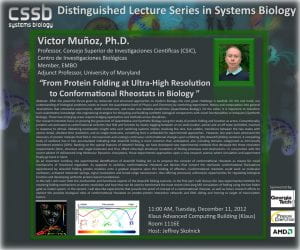Distingui shed Lecture Series Guest Speaker: Victor Muñoz
shed Lecture Series Guest Speaker: Victor Muñoz
Professor, Center for Biological Investigations, Consejo Superior de Investigaciones Cientificas (CSIC), Madrid, Spain.
Adjunct Professor, Department of Chemistry and Biochemistry, University of Maryland
Date & Time: December 11, 2012, 11:00AM
Location: Klaus 1116E
Host: Jeffrey Skolnick
Abstract: After the powerful thrust given by molecular and structural approaches to modern Biology, the next great challenge is twofold. On the one hand, our understanding of biological problems needs to reach the quantitative level of Physics and Chemistry by combining experiment, theory and computation into general descriptions that rationalize experiments, distill mechanisms, and make new testable predictions (Quantitative Biology). On the other, it is important to transform such quantitative knowledge into engineering strategies for designing and building synthetic biological components with novel functionalities or behaviors (Synthetic Biology). These two emerging areas require bridging approaches and methods across disciplines. Our research interests focus on growing the grassroots of Quantitative and Synthetic Biology using the study of protein folding and function as arena. Conventionally, proteins are portrayed as conformational switches that fold and function by slowly toggling between an on-state (native, active) and an off-state (unfolded, inactive) in response to stimuli. Obtaining mechanistic insight onto such switching systems implies resolving the rare, but sudden, transitions between the two states with atomic detail, ultrafast time resolution, and on single-molecules, something that is unfeasible for experimental approaches. However, last years have witnessed the discovery of protein modules that fold in microseconds and undergo continuous conformational changes upon unfolding (the downhill folding scenario). A compelling body of evidence has in fact accumulated indicating that downhill folding is more common than anticipated, also including domains categorized as intrinsically disordered proteins (IDPs). Banking on the special features of downhill folding, we have developed new experimental methods that decouple the three resolution requirements (time, structure and single-molecule) and thus afford ultra-high structural resolution of folding processes and mechanisms. In conjunction with the recent advent of millisecond-long Molecular Dynamics simulations, these experimental approaches open a new research avenue where simulation and experiment finally go hand in hand. As an important corollary, the experimental identification of downhill folding led us to propose the concept of conformational rheostats as means for novel mechanisms of functional regulation. As opposed to switches, conformational rheostats are devices that convert the stochastic conformational fluctuations experienced by downhill folding protein modules onto a gradual response upon the binding of effectors. Conformational rheostats could work as molecular oscillators, activated molecular springs, signal modulators and broad-range nanosensors, thus offering previously unforeseen opportunities for regulating biological function and developing synthetic protein-based nanodevices. In this talk I will cover both the mechanistic and functional aspects of the downhill folding scenario. In the first part I will discuss the new experimental methods for resolving folding mechanisms at atomic resolution and how they can be used to benchmark the most recent ultra-long MD simulations of folding using the fast folder gpW as model system. In the second, I will describe experiments that provide the proof of concept of a conformational rheostat, as well as future research efforts to explore the possible biological roles of conformational rheostats on protein-protein interaction networks and DNA sliding and homing to target of transcription factors.
Additional Info:
Group Website
University of Maryland Faculty Profile
